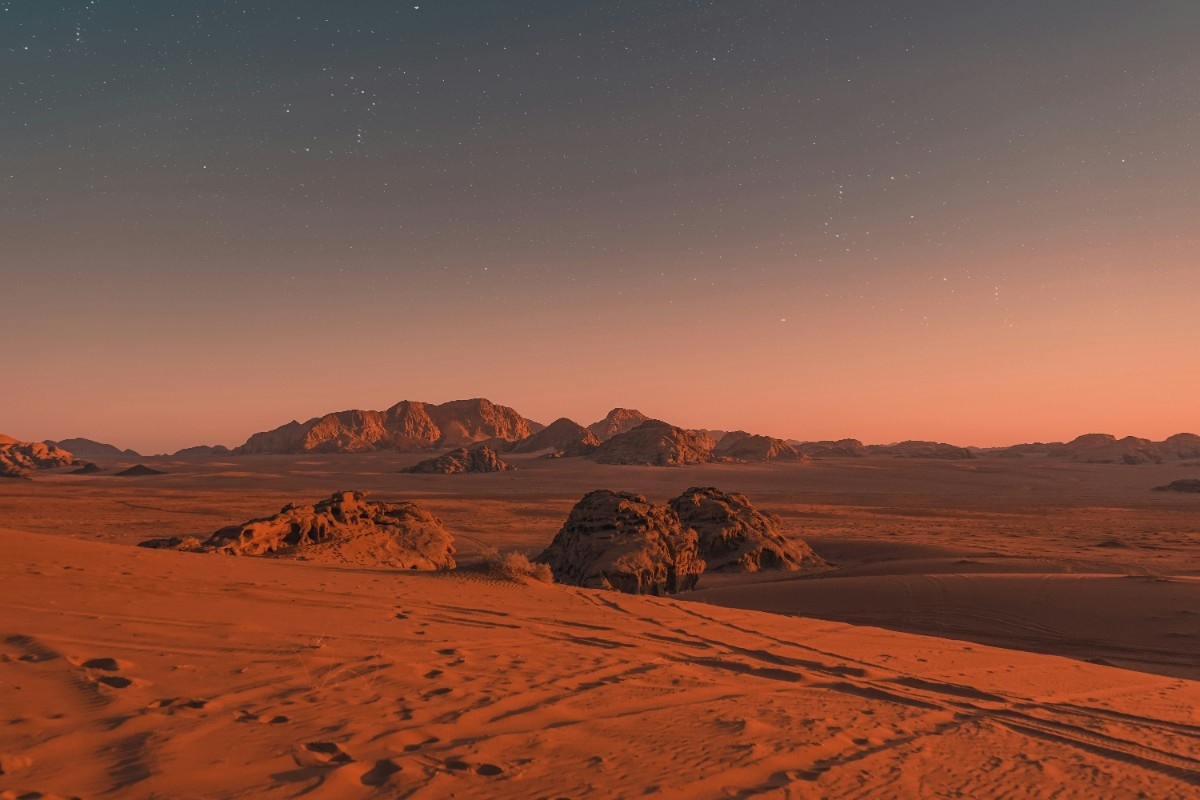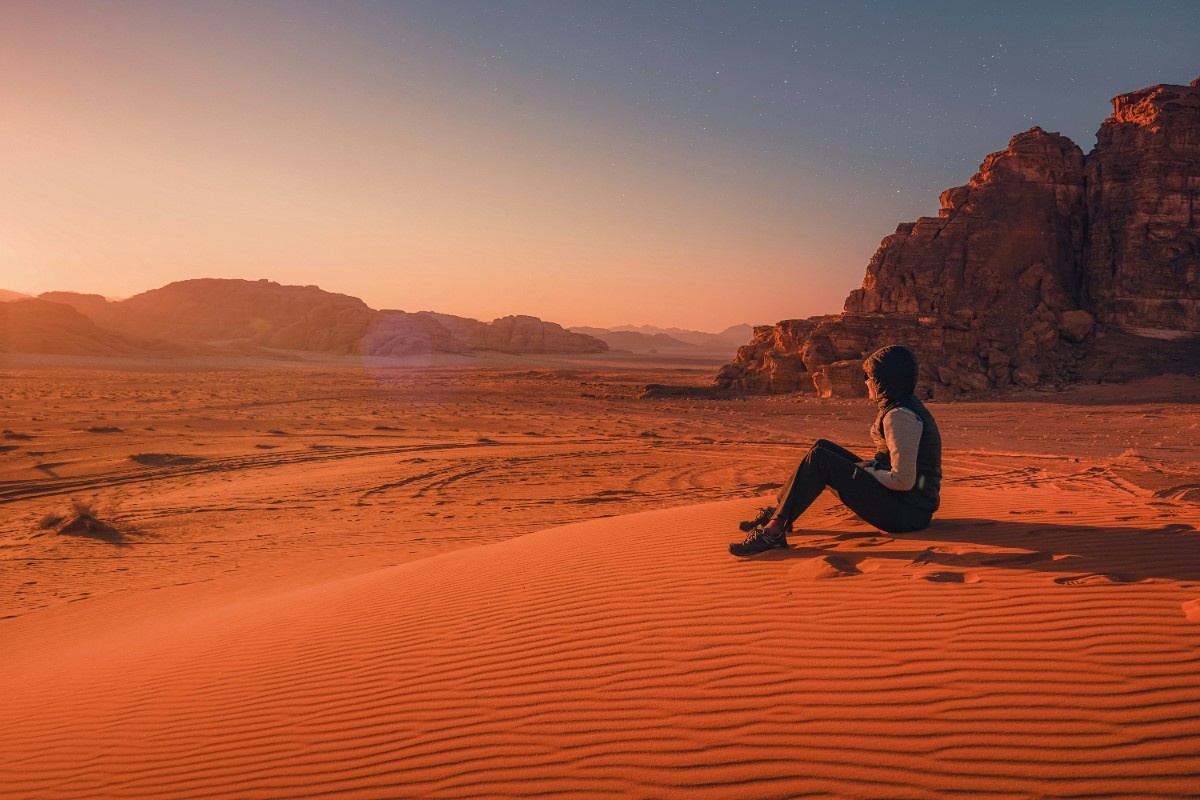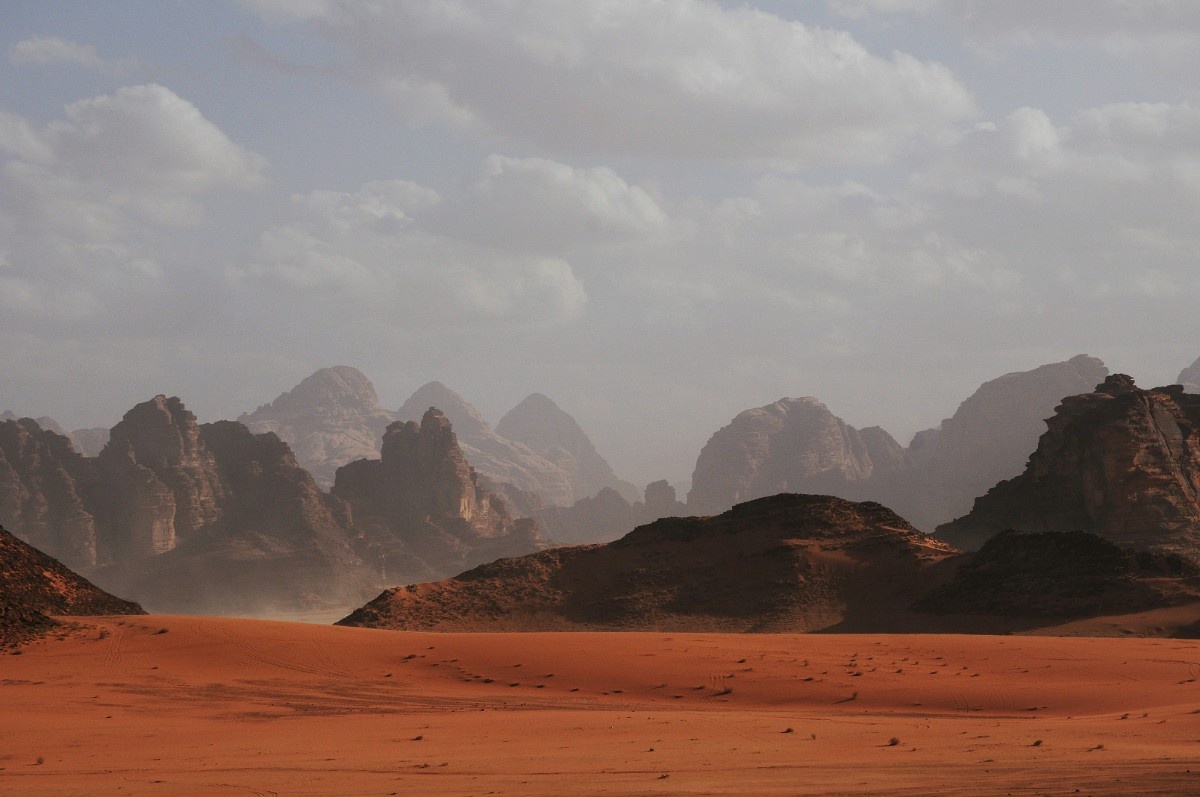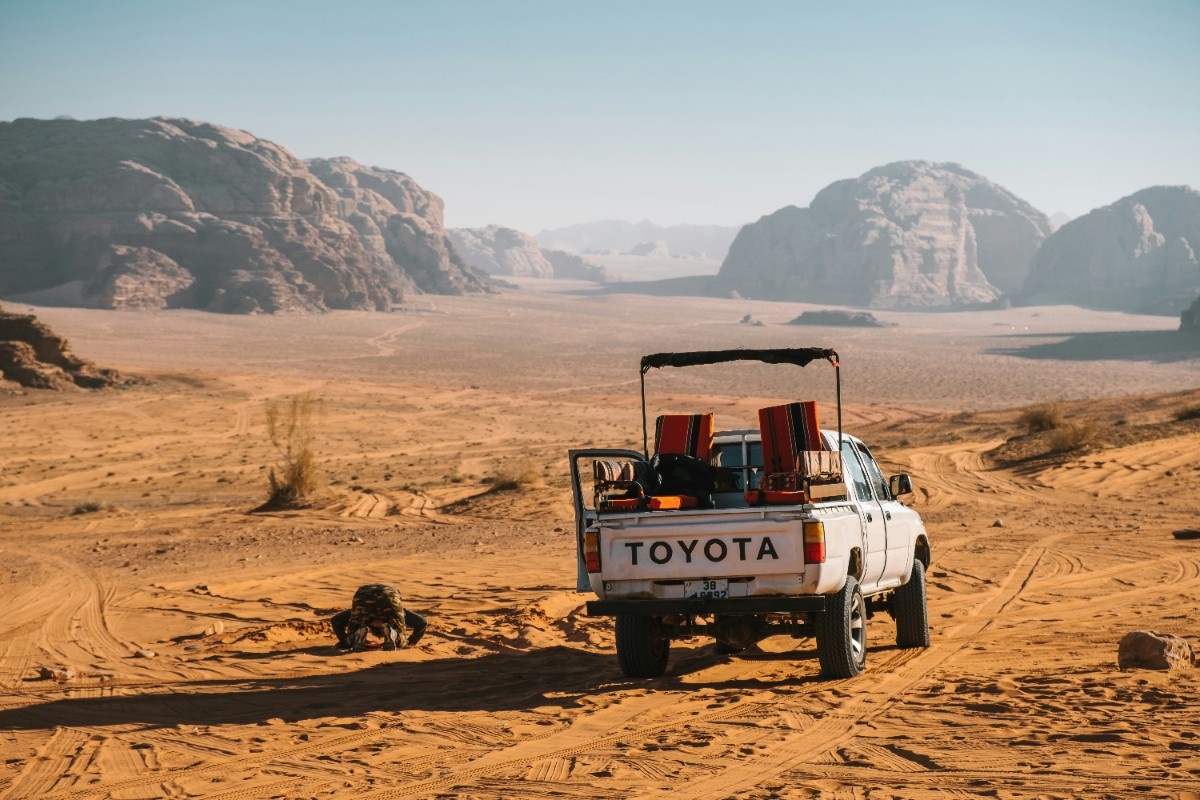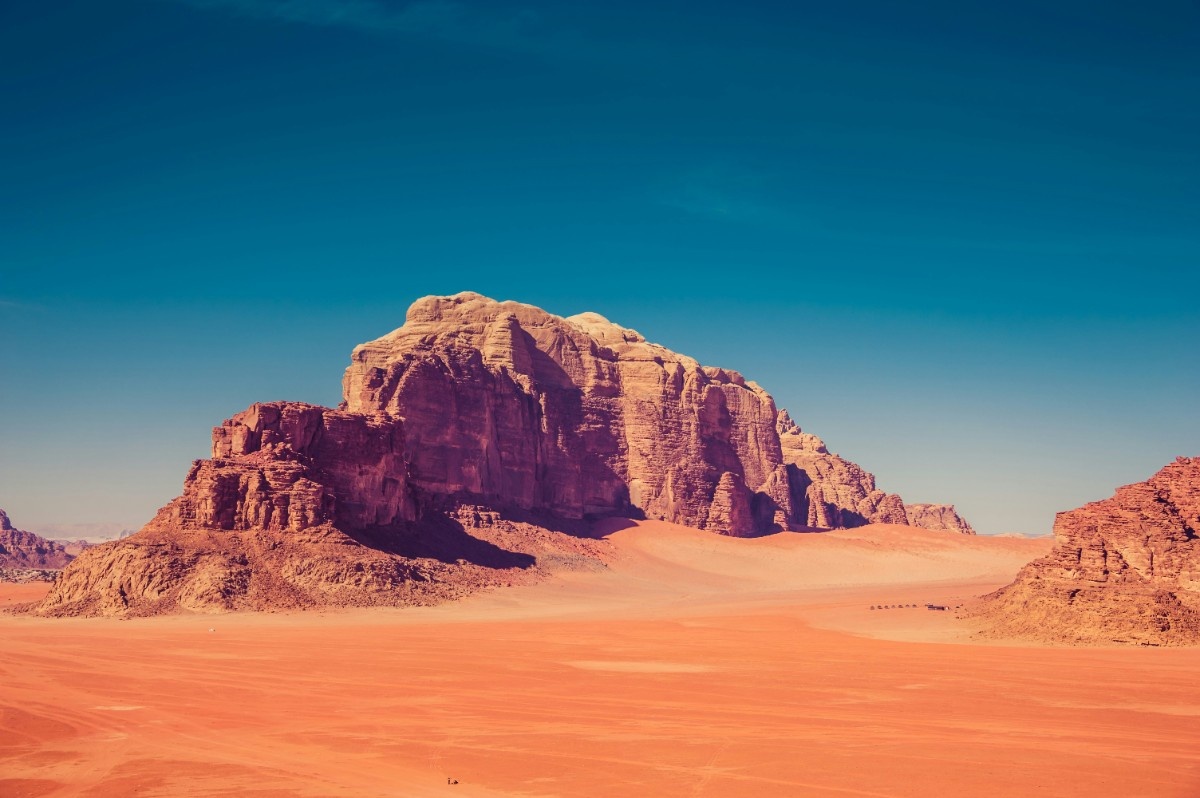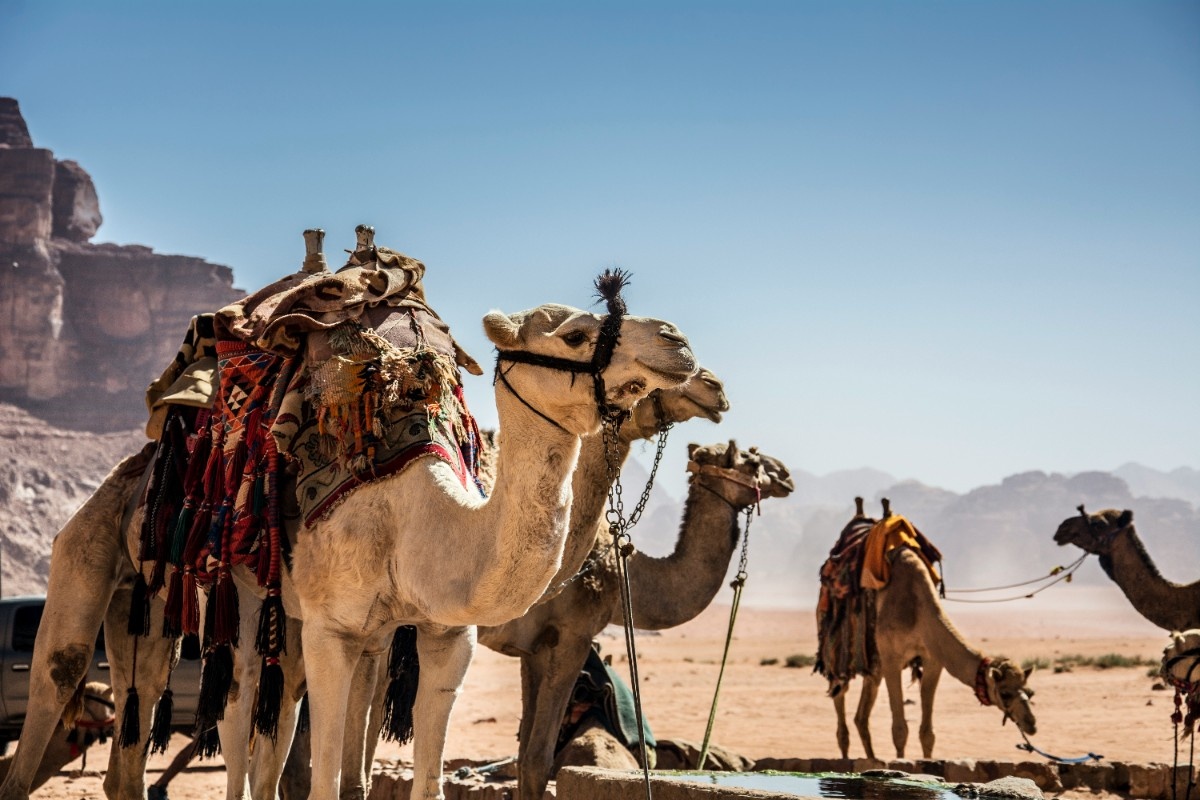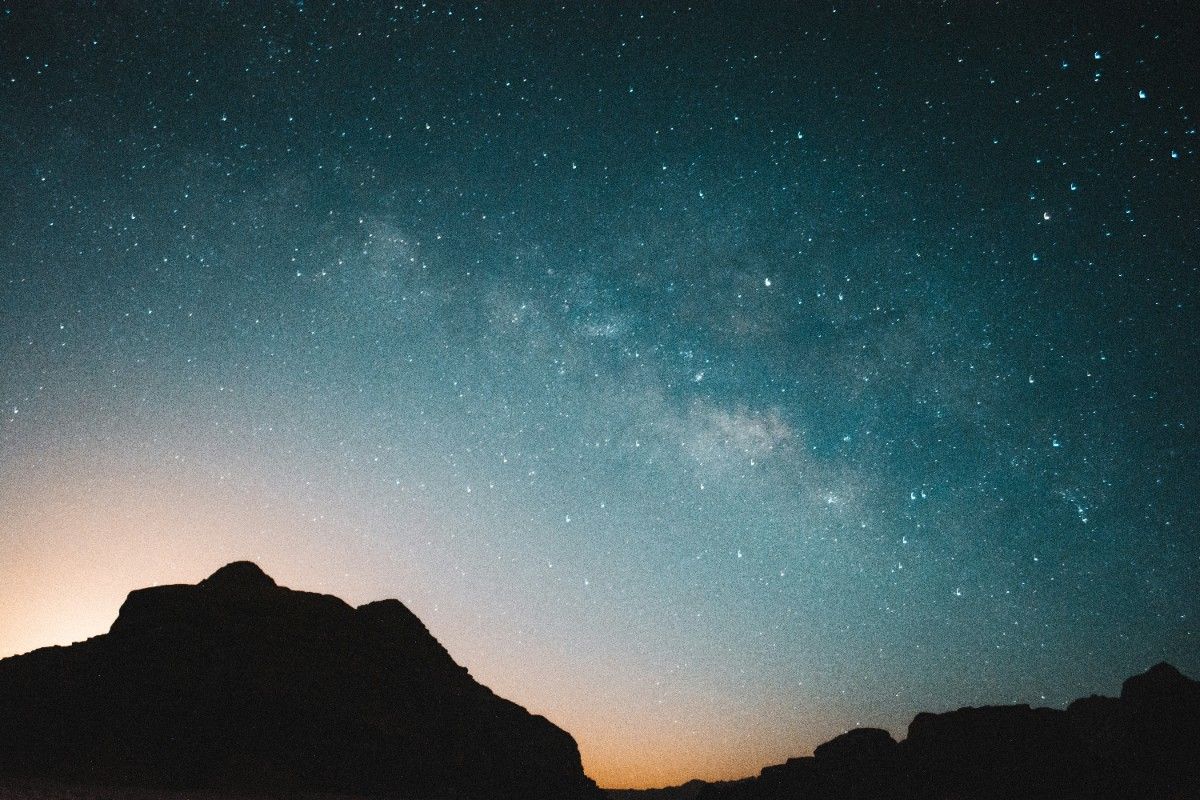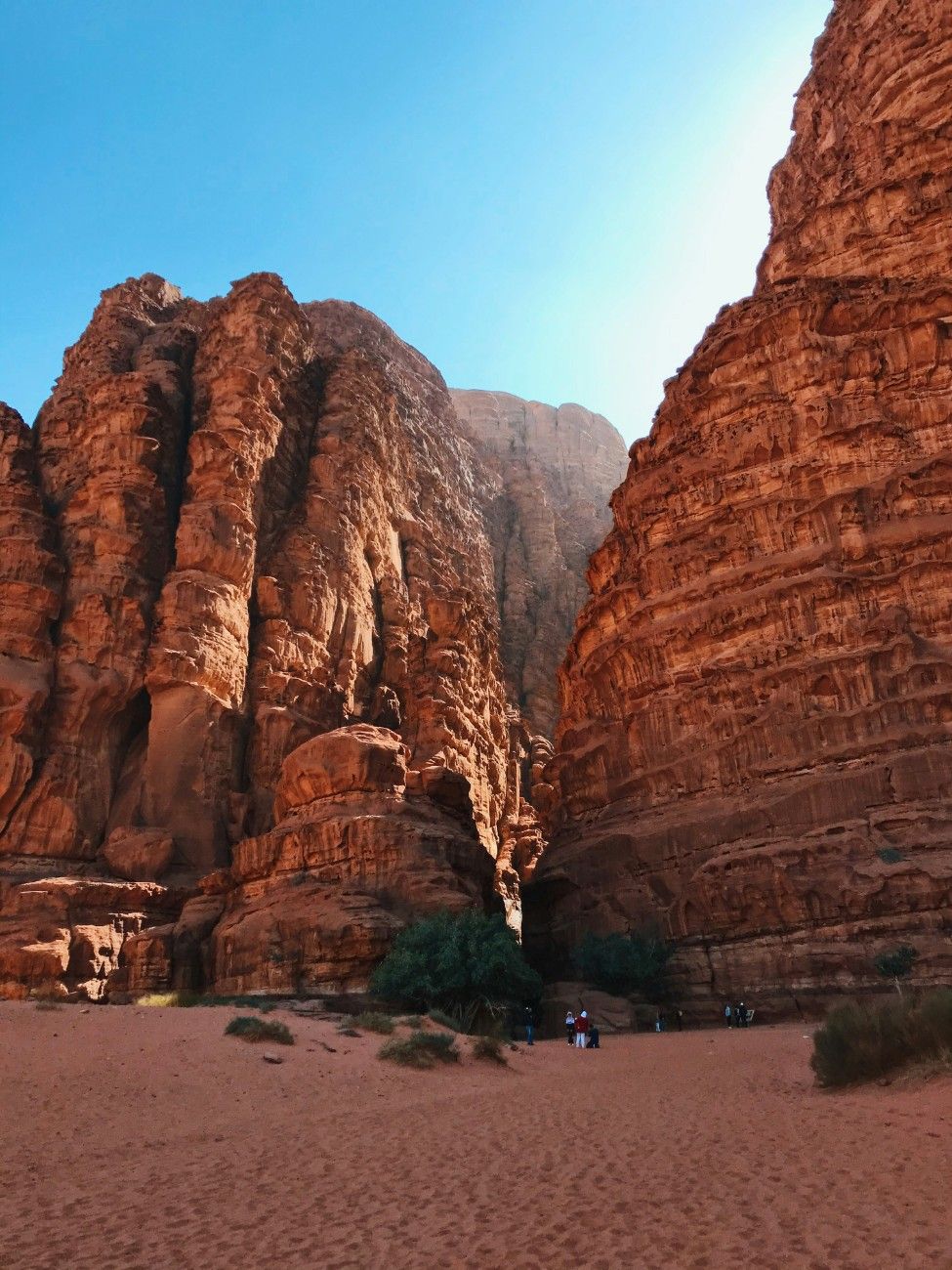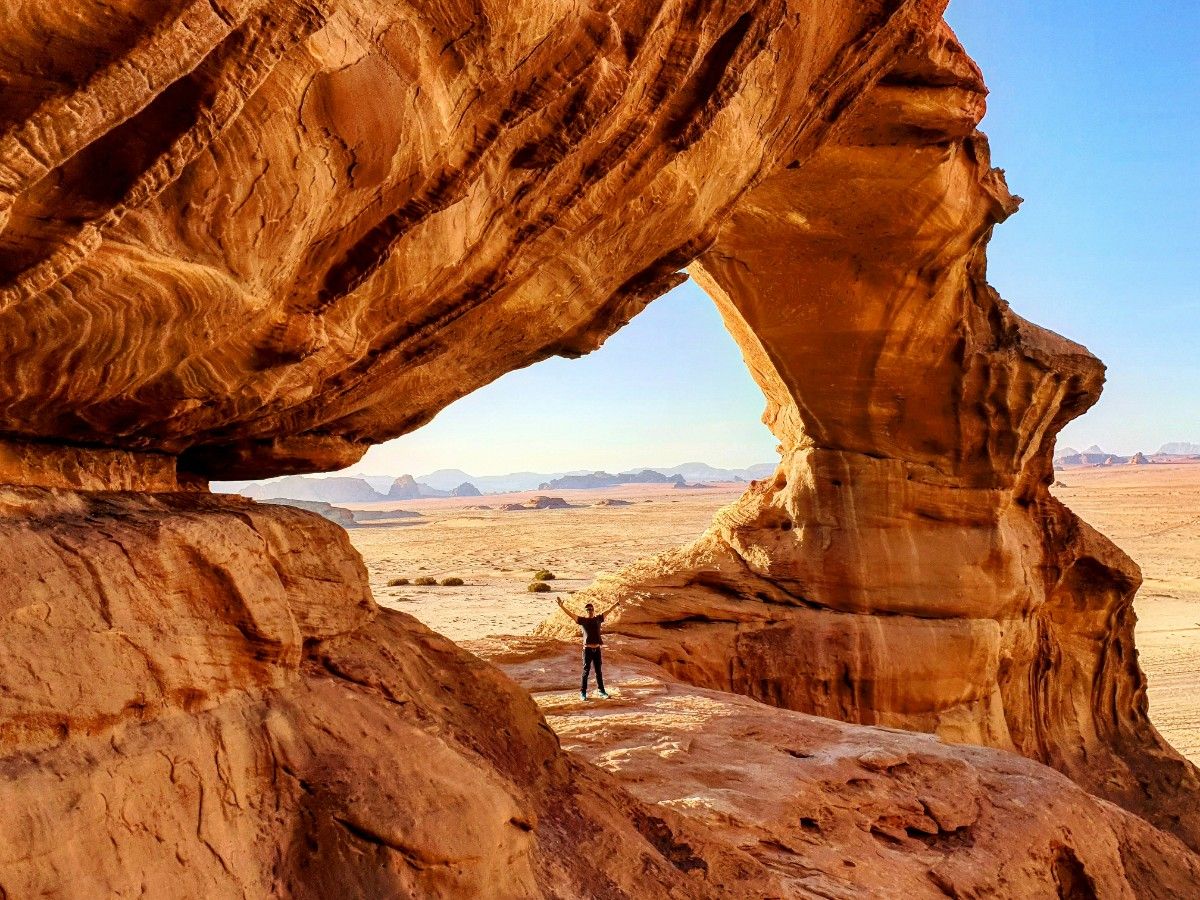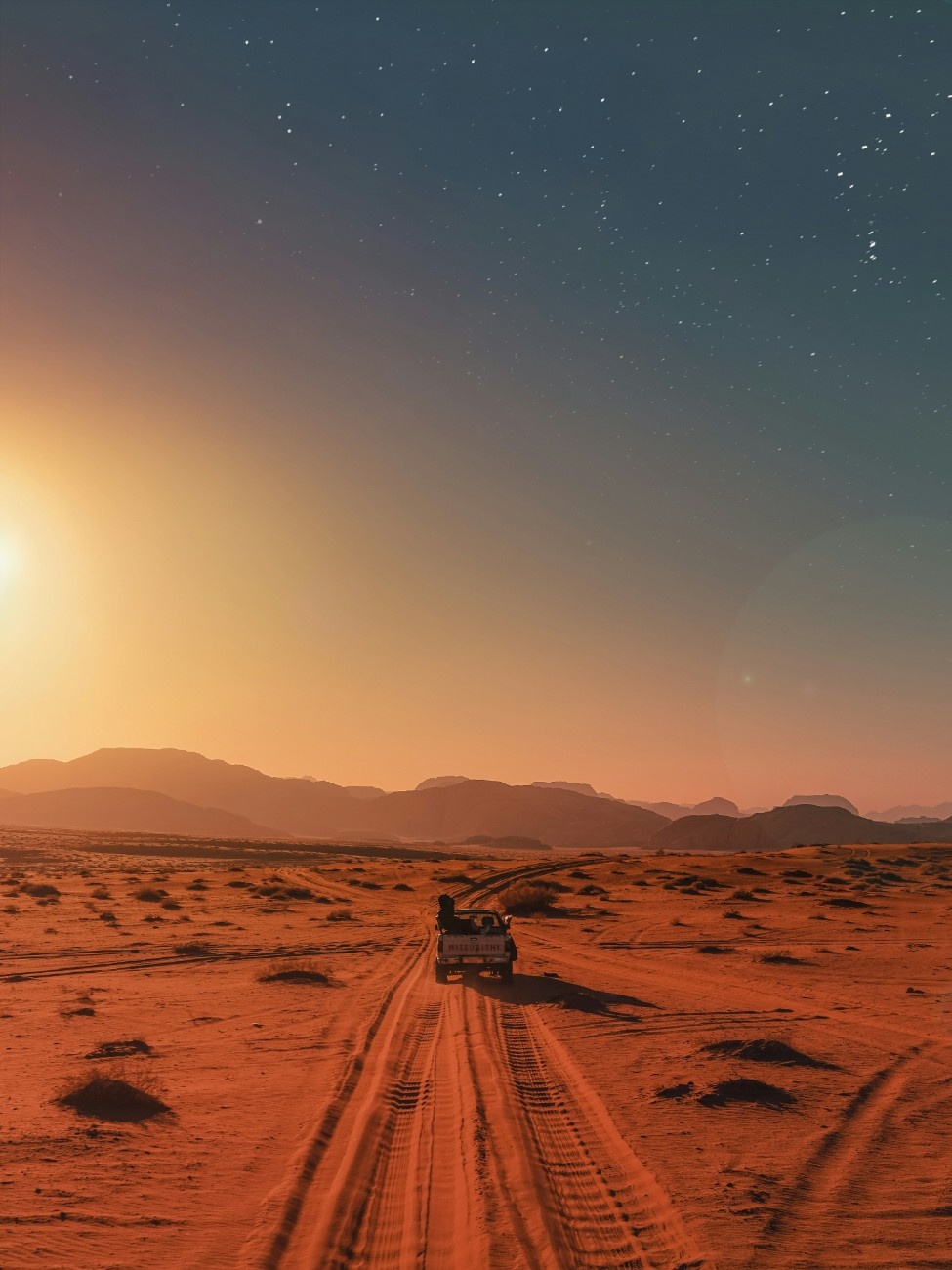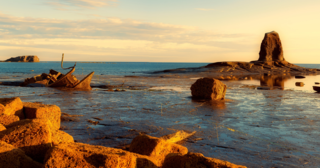Introduction to Wadi Rum National Park
Overview of Wadi Rum National Park
Wadi Rum National Park, also known as the Valley of the Moon, is a spectacular desert landscape located in southern Jordan. Spanning an area of 720 square kilometres, this UNESCO World Heritage Site is renowned for its breathtaking natural beauty, unique geological formations, and rich cultural heritage. The park's stunning red sand dunes, towering sandstone cliffs, and ancient rock carvings have captivated visitors from around the world, making it one of Jordan's most popular tourist destinations.
Geographical Location and Climate
Situated in the heart of the Arabian Desert, Wadi Rum is approximately 60 kilometres east of the city of Aqaba and 320 kilometres south of the capital city, Amman. The park's location in the desert results in a hot and dry climate, with temperatures often reaching 40°C during the summer months. However, nights can be cool, especially during the winter when temperatures occasionally drop below freezing. Rainfall is scarce, averaging just 60mm per year, which contributes to the park's arid and rugged landscape.
Significance of Wadi Rum
Wadi Rum holds great significance for its natural, cultural, and historical value. The park's unique geological features, including its massive sandstone and granite rock formations, are the result of millions of years of erosion and tectonic activity. These formations not only create a visually stunning landscape but also provide valuable insights into the Earth's geological history. Additionally, Wadi Rum has been inhabited by various human civilisations for over 12,000 years, and the park contains numerous examples of ancient rock art, inscriptions, and archaeological sites that offer a glimpse into the region's rich cultural heritage.
Bedouin Culture and Heritage
One of the most fascinating aspects of Wadi Rum National Park is its deep connection to the Bedouin people who have called this desert home for generations. The Bedouin are a nomadic Arab tribe known for their traditional way of life, which revolves around herding goats and camels, and their intimate knowledge of the desert landscape. Visitors to Wadi Rum have the opportunity to experience Bedouin hospitality firsthand, staying in traditional goat-hair tents, sharing meals around the campfire, and learning about their unique customs and traditions.
Tourism and Eco-Tourism
In recent years, Wadi Rum has become an increasingly popular destination for eco-tourism and adventure travel. The park offers a wide range of activities for visitors, including hiking, rock climbing, camel trekking, and 4x4 vehicle tours. Many of these activities are led by local Bedouin guides who possess an intimate knowledge of the landscape and can provide valuable insights into the park's natural and cultural wonders. As tourism continues to grow in Wadi Rum, efforts are being made to promote sustainable practices and minimise the impact of human activity on the fragile desert ecosystem.
Geological Marvels and Natural Wonders
Sandstone and Granite Rock Formations
One of the most striking features of Wadi Rum National Park is its towering sandstone and granite rock formations. These incredible geological structures have been shaped over millions of years by the forces of wind and water erosion, resulting in a landscape that is both visually stunning and geologically significant. The park's most famous rock formations include the Seven Pillars of Wisdom, named after T.E. Lawrence's book, and the Burdah Rock Bridge, a natural arch that spans an impressive 35 meters.
Red Sand Dunes
In addition to its rock formations, Wadi Rum is also home to vast expanses of red sand dunes that stretch as far as the eye can see. These dunes are formed by the accumulation of fine sand particles carried by the wind, and their vibrant red colour is the result of the presence of iron oxide in the sand. Visitors to Wadi Rum can experience the thrill of sandboarding down these dunes or simply marvel at the way the changing light casts shadows and highlights across their undulating surfaces.
Narrow Canyons and Hidden Valleys
Another unique feature of Wadi Rum's landscape is its network of narrow canyons and hidden valleys that wind their way through the park's rocky terrain. These canyons, such as the Khazali Canyon, offer a welcome respite from the heat of the desert sun and provide opportunities for exploration and discovery. Many of these canyons contain ancient rock carvings and inscriptions, offering a fascinating glimpse into the lives of the civilisations that once called this region home.
Unique Desert Ecosystem
Despite its arid climate and rugged terrain, Wadi Rum is home to a surprisingly diverse array of plant and animal life. The park's unique desert ecosystem has adapted to the harsh conditions of the Arabian Desert, with species such as the Sinai rose, the wild pistachio, and the Asphodel plant all found within its boundaries. Wadi Rum is also home to a variety of animal species, including the Nubian ibex, the Arabian sand gazelle, and the red fox. These species have all developed unique adaptations that allow them to survive in the challenging desert environment.
Spectacular Night Skies
Finally, one of the most awe-inspiring natural wonders of Wadi Rum National Park is its spectacular night skies. Far from the light pollution of cities and towns, the park offers some of the clearest and most breathtaking views of the stars and planets in the world. On a clear night, visitors can marvel at the vast expanse of the Milky Way stretching across the sky, and even catch glimpses of distant galaxies and constellations. Many visitors choose to spend the night in a traditional Bedouin camp, falling asleep under a blanket of stars and waking up to the stunning colours of the desert sunrise.
Cultural Heritage and Ancient Civilisations
Nabataean Presence in Wadi Rum
The Nabataeans, an ancient Arab civilisation that flourished between the 4th century BCE and the 1st century CE, left an indelible mark on the landscape of Wadi Rum. Known for their skilled rock carvings and sophisticated water management systems, the Nabataeans established a thriving network of trade routes throughout the region. In Wadi Rum, they left behind numerous examples of their architectural prowess and artistic skill, including the ancient temple of Allat and the intricate rock carvings at Khazali Canyon. These sites offer a fascinating glimpse into the lives and beliefs of this enigmatic civilisation.
Ancient Rock Art and Inscriptions
One of the most remarkable aspects of Wadi Rum's cultural heritage is its wealth of ancient rock art and inscriptions. Throughout the park, visitors can find countless examples of petroglyphs and inscriptions carved into the sandstone cliffs and rock faces. These carvings depict a wide range of subjects, from hunting scenes and animal figures to religious symbols and written inscriptions in ancient scripts such as Thamudic and Nabataean. The Anfashieh Inscriptions, for example, offer a unique insight into the Nabataean water management systems, while the petroglyphs at the Khazali Canyon showcase the artistic skill and creativity of the ancient inhabitants of this region.
Lawrence of Arabia and the Arab Revolt
In more recent history, Wadi Rum played a significant role in the Arab Revolt of 1916-1918, a pivotal moment in the region's struggle for independence from the Ottoman Empire. The British officer T.E. Lawrence, better known as "Lawrence of Arabia," used Wadi Rum as a base for his operations during the revolt, and his experiences in the desert had a profound impact on his life and legacy. Today, visitors to Wadi Rum can follow in Lawrence's footsteps, exploring the same landscapes that inspired his writings and shaped his vision of Arab independence.
Bedouin Cultural Heritage
For centuries, the Bedouin people have called the desert of Wadi Rum their home, and their traditional way of life is an integral part of the park's cultural heritage. The Bedouin are known for their hospitality, their intimate knowledge of the desert environment, and their skill in crafting beautiful textiles, jewellery, and other handicrafts. Visitors to Wadi Rum have the opportunity to experience Bedouin culture firsthand, staying in traditional goat-hair tents, sharing meals around the campfire, and learning about the customs and traditions that have sustained this remarkable community for generations.
Preserving Wadi Rum's Cultural Heritage
As tourism continues to grow in Wadi Rum, efforts are being made to preserve and protect the park's rich cultural heritage. The Jordanian government, in collaboration with organisations such as UNESCO, has implemented a range of measures to safeguard the park's archaeological sites, rock art, and traditional Bedouin practices. These efforts include the establishment of the Wadi Rum Protected Area, which seeks to balance the needs of tourism development with the imperative of cultural and environmental conservation. By working to preserve the unique cultural heritage of Wadi Rum, we can ensure that future generations will have the opportunity to experience and learn from this remarkable landscape and its people.
Adventure Activities and Experiences
Jeep and 4x4 Tours
One of the most popular ways to explore the vast expanse of Wadi Rum is by taking a jeep or 4x4 tour. These guided excursions, often led by experienced Bedouin drivers, offer a thrilling way to navigate the rugged terrain and visit some of the park's most iconic sites. From the towering red sand dunes to the ancient rock carvings and hidden oases, a jeep tour provides an immersive and unforgettable experience of the desert landscape. Many tours also include stops at traditional Bedouin camps, where visitors can enjoy a cup of sweet tea and learn about the nomadic way of life.
Camel Trekking and Hiking
For those seeking a more traditional and immersive experience of Wadi Rum, camel trekking and hiking are excellent options. Guided camel treks, led by experienced Bedouin handlers, offer a unique perspective on the desert landscape and a chance to connect with the rich cultural heritage of the region. As you sway gently atop these "ships of the desert," you'll gain a new appreciation for the vastness and beauty of Wadi Rum. Alternatively, hiking through the park's rugged terrain provides an opportunity for adventure and exploration, with trails ranging from easy walks to challenging multi-day treks.
Rock Climbing and Scrambling
Wadi Rum's towering sandstone cliffs and rock formations offer some of the best rock climbing and scrambling opportunities in the world. With routes ranging from beginner-friendly to highly technical, the park attracts climbers and adventurers from around the globe. The Bedouin guides who lead climbing expeditions in Wadi Rum are highly skilled and knowledgeable, ensuring a safe and unforgettable experience for all participants. Some of the most popular climbing spots in the park include the Burdah Rock Bridge, the Khazali Canyon, and the Jebel Rum, the highest peak in Wadi Rum.
Camping Under the Stars
One of the most magical experiences in Wadi Rum is camping under the stars in a traditional Bedouin camp. These camps, often set up in scenic locations throughout the park, offer visitors a chance to immerse themselves in the beauty and tranquillity of the desert night. After a day of exploring the park's many wonders, there's nothing quite like gathering around the campfire, sharing stories and songs with your Bedouin hosts, and then falling asleep under a canopy of stars. Many camps also offer traditional Bedouin meals, such as zarb, a delicious dish of meat and vegetables cooked in an underground oven.
Hot Air Balloon Rides
For a truly unforgettable perspective on the desert landscape of Wadi Rum, consider taking a hot air balloon ride over the park. These serene flights, which typically take place at sunrise or sunset, offer a bird's eye view of the park's stunning rock formations, vast sand dunes, and rugged terrain. As you float silently above the desert, you'll be able to appreciate the scale and grandeur of this remarkable landscape in a way that's simply not possible from the ground. With the skilled guidance of experienced pilots and the stunning colours of the desert sunrise or sunset as your backdrop, a hot air balloon ride over Wadi Rum is an adventure that you'll never forget.
Bedouin Culture and Hospitality
Traditional Bedouin Way of Life
The Bedouin people have been an integral part of Wadi Rum's cultural landscape for centuries, and their traditional way of life is a fascinating aspect of the park's heritage. Historically, the Bedouin were nomadic pastoralists who moved through the desert with their herds of goats and camels, following seasonal patterns of rainfall and vegetation. Today, while many Bedouin have settled in permanent villages, they still maintain a deep connection to the land and their traditional customs. Visitors to Wadi Rum have the opportunity to experience Bedouin hospitality firsthand, learning about their unique way of life and the challenges they face in adapting to the modern world.
Bedouin Tents and Camps
One of the most iconic symbols of Bedouin culture is the traditional goat-hair tent, known as a beit al-sha'ar or "house of hair." These tents, which are crafted by Bedouin women using the wool of black goats, provide shelter from the harsh desert sun and wind. Inside, the tents are divided into two sections: one for men and guests, and another for women and family members. Bedouin camps, which often consist of several tents arranged around a central fire pit, are the heart of social life in the desert. Visitors to Wadi Rum can stay in these camps, experiencing the warmth and hospitality of their Bedouin hosts and learning about their traditional customs and beliefs.
Bedouin Cuisine and Hospitality
Food and hospitality are central to Bedouin culture, and visitors to Wadi Rum are often struck by the warmth and generosity of their hosts. Bedouin cuisine is simple but delicious, relying on staples such as rice, bread, and meat (often goat or lamb) that are well-suited to the desert environment. One of the most famous Bedouin dishes is zarb, a traditional meal of meat and vegetables cooked in an underground oven. Bedouin hospitality dictates that guests are always offered food and drink, and it is considered impolite to refuse these offerings. Sharing a meal around the campfire with Bedouin hosts is a memorable experience that offers a glimpse into the rich cultural heritage of the desert.
Bedouin Crafts and Traditions
In addition to their hospitality and cuisine, the Bedouin are known for their skill in traditional crafts such as weaving, metalwork, and jewellery-making. Bedouin women create intricate woven textiles using wool from their sheep and goats, which are used to make rugs, cushions, and other decorative items. Bedouin men, on the other hand, are skilled in metalwork and often create beautiful silver jewellery and other ornamental objects. These crafts are not only important economic activities for Bedouin communities but also serve to maintain cultural traditions and identity. Visitors to Wadi Rum can purchase these handmade items directly from Bedouin artisans, supporting local livelihoods and preserving traditional skills.
Conservation and Sustainable Tourism
Protecting Wadi Rum's Natural Heritage
As a protected area and UNESCO World Heritage Site, Wadi Rum National Park is a global leader in conservation and sustainable tourism practices. The park's unique desert ecosystem, which includes rare and endangered species such as the Arabian oryx and the Nubian ibex, is a top priority for conservation efforts. The Jordanian government, in collaboration with international organisations and local communities, has implemented a range of measures to protect the park's biodiversity and minimise the impact of human activities. These measures include monitoring wildlife populations, regulating visitor access to sensitive areas, and promoting eco-friendly tourism practices.
Preserving Cultural Heritage
In addition to its natural wonders, Wadi Rum is also home to a rich cultural heritage that includes ancient rock art, inscriptions, and archaeological sites. Preserving this cultural heritage is an important part of the park's conservation efforts, and measures have been put in place to protect these valuable resources. The Jordanian Department of Antiquities, in collaboration with international partners, has conducted extensive surveys and excavations of the park's archaeological sites, documenting and preserving them for future generations. Visitors to Wadi Rum are encouraged to respect these sites and to avoid damaging or removing any artifacts or rock art.
Sustainable Tourism Practices
Sustainable tourism is a key priority for Wadi Rum National Park, and the park has implemented a range of measures to minimise the environmental impact of visitor activities. These measures include promoting eco-friendly accommodations, such as solar-powered camps and eco-lodges, and encouraging visitors to follow Leave No Trace principles when exploring the park. The park also works closely with local Bedouin communities to develop sustainable tourism initiatives that provide economic opportunities while preserving traditional ways of life. By supporting these initiatives, visitors can help to ensure that the benefits of tourism are shared equitably and that the park's natural and cultural heritage is protected for future generations.
Engaging Local Communities
One of the most important aspects of sustainable tourism in Wadi Rum is the engagement and empowerment of local Bedouin communities. For centuries, the Bedouin have been the stewards of this desert landscape, and their traditional knowledge and practices are essential to the park's long-term conservation. The park works closely with Bedouin communities to develop sustainable tourism initiatives that provide economic opportunities and support traditional livelihoods. These initiatives include training programs for Bedouin guides, the development of community-based tourism projects, and the promotion of traditional handicrafts and cultural experiences. By supporting these initiatives, visitors can help to create a more equitable and sustainable future for the people of Wadi Rum.
Planning Your Visit to Wadi Rum
When to Visit
When planning your visit to Wadi Rum National Park, it's important to consider the time of year and the weather conditions. The best time to visit is generally between March and May or September and November, when temperatures are mild and comfortable for outdoor activities. During the summer months (June to August), temperatures can soar to over 40°C (104°F), making it challenging to explore the park during the day. Winter months (December to February) can be cold, especially at night, with temperatures sometimes dropping below freezing. However, if you're prepared for the cold, winter can be a beautiful time to visit, with smaller crowds and stunning light for photography.
Getting There
Wadi Rum is located in southern Jordan, approximately 320 kilometres (200 miles) south of the capital city, Amman. The nearest major city is Aqaba, which is about 60 kilometres (37 miles) to the south. There are several options for getting to Wadi Rum, including rental cars, taxis, and public buses. If you're driving, be sure to take the Desert Highway (Highway 15) from Amman or Aqaba, and then follow the signs to Wadi Rum Village. If you're taking public transportation, there are regular buses from Amman and Aqaba to Wadi Rum Village, where you can arrange for a tour or transfer to your accommodation within the park.
Accommodation Options
There are several options for accommodation within Wadi Rum National Park, ranging from basic campsites to luxurious eco-lodges. One of the most popular options is to stay in a traditional Bedouin camp, which offers a unique and immersive experience of the desert landscape and culture. These camps typically consist of large, comfortable tents with beds, linens, and sometimes even private bathrooms. Many camps also offer traditional Bedouin meals and activities such as camel rides and guided hikes. For those seeking more modern comforts, there are also several eco-lodges and luxury camps within the park that offer amenities such as air conditioning, private bathrooms, and swimming pools.
Tours and Activities
There are many ways to explore Wadi Rum National Park, depending on your interests and physical abilities. One of the most popular options is to take a jeep or 4x4 tour, which allows you to cover a lot of ground and visit some of the park's most famous sites, such as the Seven Pillars of Wisdom and the Burdah Rock Bridge. Camel treks and hiking tours are also popular options, allowing you to experience the park at a slower pace and connect with the landscape in a more intimate way. For the more adventurous, there are also opportunities for rock climbing, hot air balloon rides, and even overnight camping trips under the stars. When choosing a tour or activity, be sure to go with a reputable operator and guide who prioritises safety and sustainability.
Wadi Rum in Popular Culture and Imagination
Lawrence of Arabia
One of the most famous cultural associations with Wadi Rum is its connection to the British officer T.E. Lawrence, better known as "Lawrence of Arabia." During the Arab Revolt of 1916-1918, Lawrence used Wadi Rum as a base for his operations against the Ottoman Empire, and he wrote extensively about his experiences in the desert in his memoir, "Seven Pillars of Wisdom." Lawrence's vivid descriptions of the landscape and the Bedouin people helped to cement Wadi Rum's place in the Western cultural imagination, and his legacy continues to draw visitors to the park to this day. In 1962, the film "Lawrence of Arabia" was released, which was partially filmed in Wadi Rum and further popularised the landscape's association with the famed British officer.
Wadi Rum in Film
In addition to its association with Lawrence of Arabia, Wadi Rum has also been featured in numerous other films and television shows over the years. The park's otherworldly landscape, with its towering red cliffs and vast expanses of sand, has made it a popular location for science fiction and fantasy films in particular. Some notable examples include "Red Planet" (2000), "Prometheus" (2012), "The Martian" (2015), and "Star Wars: Rogue One" (2016). In these films, Wadi Rum often serves as a stand-in for alien landscapes or distant planets, showcasing the unique and awe-inspiring beauty of the desert. The use of Wadi Rum in popular media has helped to raise the profile of the park and attract visitors from around the world who are eager to experience its stunning vistas firsthand.
Wadi Rum in Literature and Art
Beyond its appearances on the big screen, Wadi Rum has also inspired countless writers, poets, and artists over the years. In addition to T.E. Lawrence's writings, the park has been featured in works by other notable authors, such as the travel writer Bruce Chatwin and the poet William Wordsworth. The unique colours and shapes of the desert landscape have also been a source of inspiration for visual artists, from painters and photographers to sculptors and installation artists. The abstract and often surreal qualities of Wadi Rum's rock formations and sand dunes have lent themselves to a wide range of artistic interpretations and styles, from realistic depictions to more symbolic or conceptual works.
Wadi Rum and Adventure Culture
In recent years, Wadi Rum has become increasingly associated with adventure and extreme sports culture, as the park's rugged terrain and vast expanses of sand make it an ideal location for activities such as rock climbing, sandboarding, and off-road vehicle racing. The park's association with adventure and exploration has helped to attract a new generation of visitors who are seeking to push their limits and experience the raw beauty of the desert in a more intense and immersive way. This trend has also led to the development of new adventure tourism offerings within the park, such as hot air balloon rides and multi-day camping and hiking expeditions, which allow visitors to experience Wadi Rum in a more challenging and unconventional way.
Related Articles

Let us know you agree to cookies
We use marketing, analytical and functional cookies as well as similar technologies to give you the best experience. Third parties, including social media platforms, often place tracking cookies on our site to show you personalised adverts outside of our website.
We store your cookie preferences for two years and you can edit your preferences via ‘manage cookies’ or through the cookie policy at the bottom of every page. For more information, please see our cookie policy.
